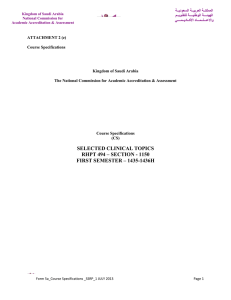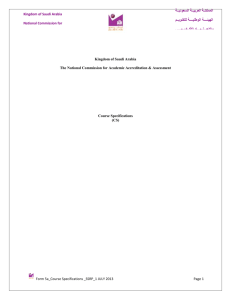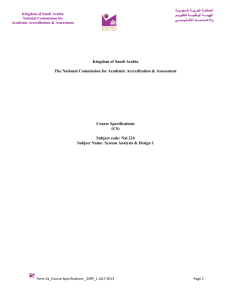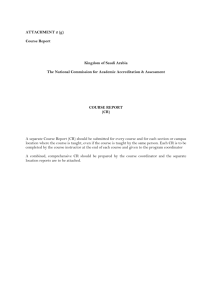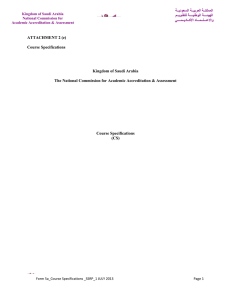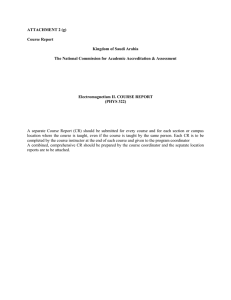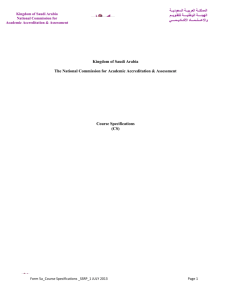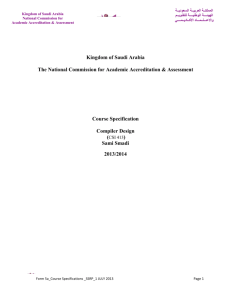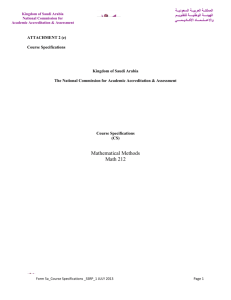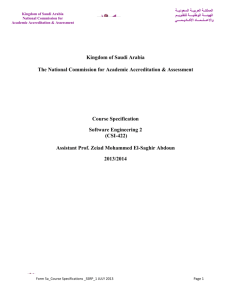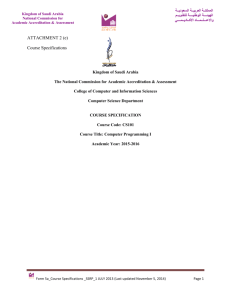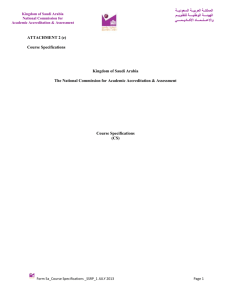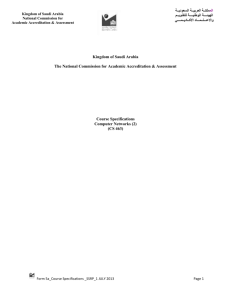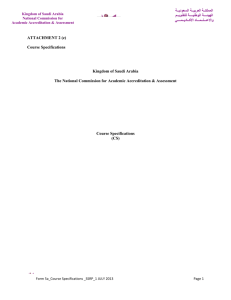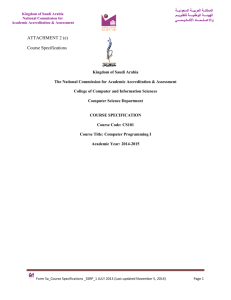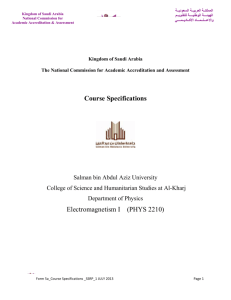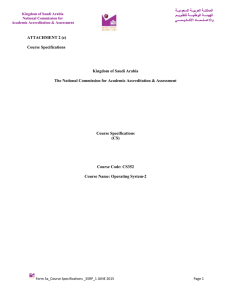Course Specifications
advertisement
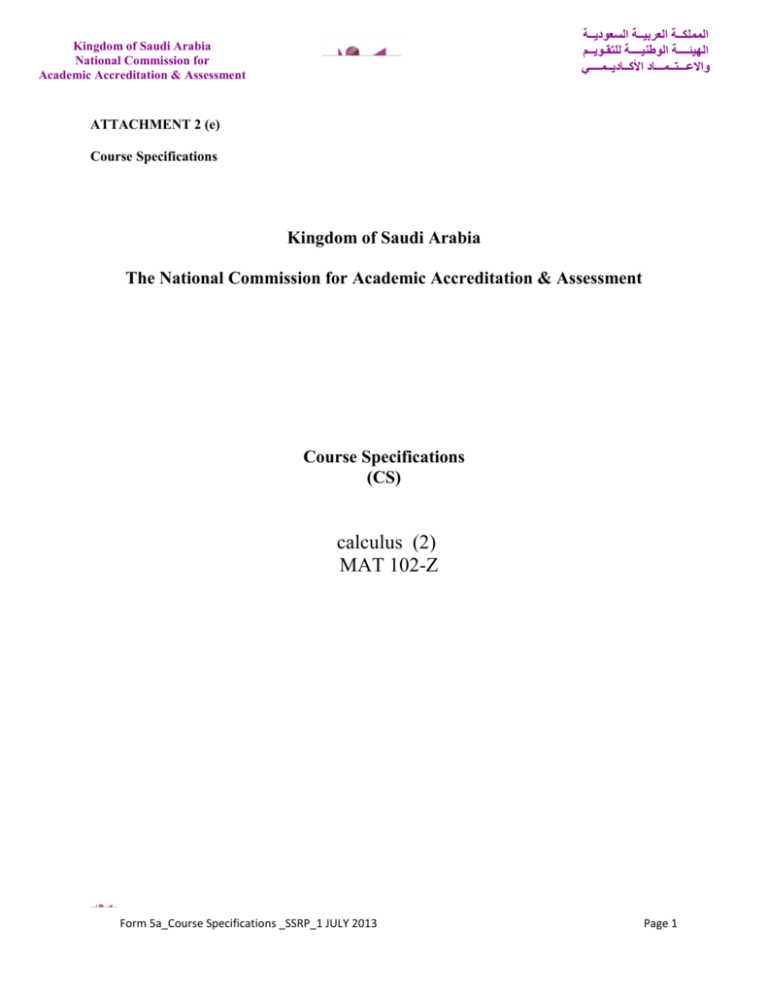
المملكــة العربيــة السعوديــة الهيئــــة الوطنيــــة للتقـويــم واالعـــتــمـــاد األكــاديــمــــي Kingdom of Saudi Arabia National Commission for Academic Accreditation & Assessment ATTACHMENT 2 (e) Course Specifications Kingdom of Saudi Arabia The National Commission for Academic Accreditation & Assessment Course Specifications (CS) calculus (2) MAT 102-Z Form 5a_Course Specifications _SSRP_1 JULY 2013 Page 1 المملكــة العربيــة السعوديــة الهيئــــة الوطنيــــة للتقـويــم واالعـــتــمـــاد األكــاديــمــــي Kingdom of Saudi Arabia National Commission for Academic Accreditation & Assessment Course Specifications Institution : Majmaah University Date of Report 13/5/1435 College/Department Faculty of Science / Mathematics Department A. Course Identification and General Information 1. Course title and code: calculus (2) , MAT 102-Z 2. Credit hours 3 Hours 3. Program(s) in which the course is offered. (If general elective available in many programs indicate this rather than list programs) 4. Name of faculty member responsible for the course 5. Level/year at which this course is offered 6. Pre-requisites for this course (if any) KAMAL NAZMI Third (chemistry – physics) MAT 101 7. Co-requisites for this course (if any) 8. Location if not on main campus Main Campus , Zulfi city 9. Mode of Instruction (mark all that apply) a. Traditional classroom What percentage? b. Blended (traditional and online) What percentage? c. e-learning What percentage? d. Correspondence What percentage? f. Other What percentage? 90 % 10% %% Comments: Form 5a_Course Specifications _SSRP_1 JULY 2013 Page 2 Kingdom of Saudi Arabia National Commission for Academic Accreditation & Assessment المملكــة العربيــة السعوديــة الهيئــــة الوطنيــــة للتقـويــم واالعـــتــمـــاد األكــاديــمــــي B Objectives 1. What is the main purpose for this course? a) b) c) d) e) Definition of the concept of integration and the relation between Integration and Area Statement of the basic rules for the indefinite Integral Use different methods to calculate the integration Computing the integrals Trigonometrical functions,exponential and Logarithmic functions Computing the integrals of Hyperbolic functions and the inverse of Hyperbolic functions and their derivatives 2. Briefly describe any plans for developing and improving the course that are being implemented. (e.g. increased use of IT or web based reference material, changes in content as a result of new research in the field) 1- Access to research and recent studies related topics and benefit from 2- Establishment of workshops within the department 3-Cooprate with other educational institutions to find how they deal with the subject. 4- Re- new the course references frequently. 5-Frequently check the latest discovery in science to improve the course objectives. 6- The course needs the use of computers. 7- Posting some course material on the websites to help the students. 8- Focusing on generic skills. Form 5a_Course Specifications _SSRP_1 JULY 2013 Page 3 المملكــة العربيــة السعوديــة الهيئــــة الوطنيــــة للتقـويــم واالعـــتــمـــاد األكــاديــمــــي Kingdom of Saudi Arabia National Commission for Academic Accreditation & Assessment C. Course Description (Note: General description in the form to be used for the Bulletin or handbook should be attached) Topics to be cover Contact hours List of Topic No. of Weeks Lecture tutorials 6 3 4 2 Definite integral and its properties Mean value theorem of integral – the fundamental theorem of calculus – indefinite integral 2 2 Mid-term 1 Standard integrals – derivatives & integrals of hyperbolic functions and inverse of hyperbolic functions Integration methods: integration by substitution – integration by parts 2 Office Hours Self- Study total Discussions Internet Library Homework 9 1 1 1 1 13 6 2 1 1 1 11 2 2 8 4 12 1 2 1 1 17 6 3 9 1 1 1 1 13 4 2 Mid-term 2 Integration by partial fractions – other substitutions L’ Hospitals Rule – Improper integrals Lab Total of contact 2 2 2 Review Final Exam Total Form 5a_Course Specifications _SSRP_1 JULY 2013 2 2 6 3 9 1 1 1 1 13 6 3 9 1 1 1 1 13 2 2 8 8 4 2 90 2 2 60 7 Note: one credit hour is equal 25 – 30 load work hour Page 4 8 المملكــة العربيــة السعوديــة الهيئــــة الوطنيــــة للتقـويــم واالعـــتــمـــاد األكــاديــمــــي Kingdom of Saudi Arabia National Commission for Academic Accreditation & Assessment 2. Course components (total contact hours and credits per semester): Credit 3 Lecture 36 Contact Hours Tutorial Laboratory 18 Self-Study Other Total Practical 36 2. Additional private study/learning hours expected for students per week. 90 3 Hours 3. Course Learning Outcomes in NQF Domains of Learning and Alignment with Assessment Methods and Teaching Strategy Course Learning Outcomes, Assessment Methods, and Teaching Strategy work together and are aligned. They are joined together as one, coherent, unity that collectively articulate a consistent agreement between student learning, assessment, and teaching. The National Qualification Framework provides five learning domains. Course learning outcomes are required. Normally a course has should not exceed eight learning outcomes which align with one or more of the five learning domains. Some courses have one or more program learning outcomes integrated into the course learning outcomes to demonstrate program learning outcome alignment. The program learning outcome matrix map identifies which program learning outcomes are incorporated into specific courses. On the table below are the five NQF Learning Domains, numbered in the left column. First, insert the suitable and measurable course learning outcomes required in the appropriate learning domains (see suggestions below the table). Second, insert supporting teaching strategies that fit and align with the assessment methods and intended learning outcomes. Third, insert appropriate assessment methods that accurately measure and evaluate the learning outcome. Each course learning outcomes, assessment method, and teaching strategy ought to reasonably fit and flow together as an integrated learning and teaching process. Fourth, if any program learning outcomes are included in the course learning outcomes, place the @ symbol next to it. Every course is not required to include learning outcomes from each domain. Form 5a_Course Specifications _SSRP_1 JULY 2013 Page 5 المملكــة العربيــة السعوديــة الهيئــــة الوطنيــــة للتقـويــم واالعـــتــمـــاد األكــاديــمــــي Kingdom of Saudi Arabia National Commission for Academic Accreditation & Assessment 1.0 1.1 1.2 NQF Learning Domains And Course Learning Outcomes Knowledge a) Knowledge of basic rules and laws and integration properties b) skill of derivatives and integration for exponential functions and algorithmic functions c) Derived And integrates hyperbolic functions and inverse hyperbolic functions. d) Integrates the trigonometric functions Knowledge of integration methods ( by substitutions, parts, partial fractions,…..) Outline the logical thinking. Course Teaching Strategies Start each chapter by general idea and the benefit of it. Demonstrate the course Course Assessment Methods Exams Midterms Final examination. information and principles through lectures. Provide main ways to deal Home work. with the exercises. State the physical problems by mathematical Solve some examples method. during the lecture. 2.0 Cognitive Skills 2.1 The students will explain and interpret a general knowledge of Linear Algebra. Encourage the student to look for some complicated Continuous discussions with the students during the lectures. Midterm exams Quizzes. problems in the different references. 2.2 Enable students to analyses the mathematical problems. Student's ability to write physical equations in a correct mathematical way. 3.0 Interpersonal Skills & Responsibility 3.1 The student should illustrate how take up responsibility. Ask the student to attend lectures for practice solving problem. Homework assignments. Doing homework. Check the problems solution. Discussion of how to simplify or analyses some problems. Ask the students to search Quizzes of some previous lectures. Ask the absent students about last lecture. the internet and use the library. Encourage them how to Form 5a_Course Specifications _SSRP_1 JULY 2013 Page 6 المملكــة العربيــة السعوديــة الهيئــــة الوطنيــــة للتقـويــم واالعـــتــمـــاد األكــاديــمــــي Kingdom of Saudi Arabia National Commission for Academic Accreditation & Assessment attend lectures regularly by assigning marks for attendance. 3.2 Must be shown the ability of working independently and with groups. Discussion during the lecture. 4.0 Teach them how to cover missed lectures. Give students tasks of duties Communication, Information Technology, Numerical 4.1 The student should illustrate how to Creating working groups with peers to collectively prepare: solving problems and search the internet for some topics. Discussing a group work Give the students tasks to measure their: mathematical skills, computational analysis and problem solving. Encourage the student to ask for help if needed. Discuses with them the results of computations analysis and problem solutions. communicating with: Peers, Lecturers and Community. 4.2 The student should interpret how to Know the basic mathematical principles using the internet. The student should appraise how to Use the computer skills and library. Encourage the student to ask good question to help solve the problem. 5.0 The student should illustrate how to Search the internet and using software programs to deal with problems. Psychomotor 5.1 5.2 Not applicable Not applicable Not applicable Not applicable sheets. Give homework's to know how the student understands the numerical skills. Give them comments on some resulting numbers. Not applicable Not applicable Suggested Guidelines for Learning Outcome Verb, Assessment, and Teaching NQF Learning Domains Suggested Verbs Knowledge Cognitive Skills Interpersonal Skills & Responsibility list, name, record, define, label, outline, state, describe, recall, memorize, reproduce, recognize, record, tell, write estimate, explain, summarize, write, compare, contrast, diagram, subdivide, differentiate, criticize, calculate, analyze, compose, develop, create, prepare, reconstruct, reorganize, summarize, explain, predict, justify, rate, evaluate, plan, design, measure, judge, justify, interpret, appraise demonstrate, judge, choose, illustrate, modify, show, use, appraise, evaluate, justify, analyze, question, and write Form 5a_Course Specifications _SSRP_1 JULY 2013 Page 7 المملكــة العربيــة السعوديــة الهيئــــة الوطنيــــة للتقـويــم واالعـــتــمـــاد األكــاديــمــــي Kingdom of Saudi Arabia National Commission for Academic Accreditation & Assessment Communication, Information Technology, Numerical demonstrate, calculate, illustrate, interpret, research, question, operate, appraise, evaluate, assess, and criticize Psychomotor demonstrate, show, illustrate, perform, dramatize, employ, manipulate, operate, prepare, produce, draw, diagram, examine, construct, assemble, experiment, and reconstruct Suggested verbs not to use when writing measurable and assessable learning outcomes are as follows: Consider Maintain Maximize Continue Review Ensure Enlarge Understand Reflect Examine Strengthen Explore Encourage Deepen Some of these verbs can be used if tied to specific actions or quantification. Suggested assessment methods and teaching strategies are: According to research and best practices, multiple and continuous assessment methods are required to verify student learning. Current trends incorporate a wide range of rubric assessment tools; including web-based student performance systems that apply rubrics, benchmarks, KPIs, and analysis. Rubrics are especially helpful for qualitative evaluation. Differentiated assessment strategies include: exams, portfolios, long and short essays, log books, analytical reports, individual and group presentations, posters, journals, case studies, lab manuals, video analysis, group reports, lab reports, debates, speeches, learning logs, peer evaluations, self-evaluations, videos, graphs, dramatic performances, tables, demonstrations, graphic organizers, discussion forums, interviews, learning contracts, antidotal notes, artwork, KWL charts, and concept mapping. Differentiated teaching strategies should be selected to align with the curriculum taught, the needs of students, and the intended learning outcomes. Teaching methods include: lecture, debate, small group work, whole group and small group discussion, research activities, lab demonstrations, projects, debates, role playing, case studies, guest speakers, memorization, humor, individual presentation, brainstorming, and a wide variety of hands-on student learning activities. Form 5a_Course Specifications _SSRP_1 JULY 2013 Page 8 المملكــة العربيــة السعوديــة الهيئــــة الوطنيــــة للتقـويــم واالعـــتــمـــاد األكــاديــمــــي Kingdom of Saudi Arabia National Commission for Academic Accreditation & Assessment 5. Schedule of Assessment Tasks for Students During the Semester Assess Assessment task (eg. essay, test, group project, ment examination etc.) Week due Proportion of Final Assessment 1 Midterm 1 5th week 15 % 2 Midterm 1 10th week 2015% 3 Homework + reports During the 10% semester 4 Final exam End of 60 % semester D. Student Academic Counseling and Support 1. Arrangements for availability of faculty and teaching staff for individual student consultations and academic advice. (include amount of time teaching staff are expected to be available each week) 1- 6-office hours per week in the lecturer schedule. 2- The contact with students by e-mail , mobile, office telephone and website. E. Learning Resources 1. Required Text(s) 1- H . Anton : Calculus with analytic , 4th edition, John Wiely & sons, New York ,2002 2. Essential References 2-Swokowski,Olinick,and pence :Calculus ,sixth Edition .John Wiely & sons ,New York 3-Calculus by Ron Larson and Bruce H. Edwards (Jan 1, 2013) , 10th edition 3- Recommended Books and Reference Material (Journals, Reports, etc) (Attach List): Same as mention above. 4-.Electronic Materials, Web Sites etc Calculus With Analytic Geometry, Seventh Edition | CD | 121 MB Form 5a_Course Specifications _SSRP_1 JULY 2013 Page 9 المملكــة العربيــة السعوديــة الهيئــــة الوطنيــــة للتقـويــم واالعـــتــمـــاد األكــاديــمــــي Kingdom of Saudi Arabia National Commission for Academic Accreditation & Assessment Calculus fifth edu With Analytic Geometry: Student Solution Manual ...calculus larson, 0, كتابcalculus and analytic geometry أمازون دوت كوم, ... university.arabsbook.com/.../32376-Calculus-With-Analytic-Geometry-Seventh-Edition-CD-121 5- Other learning material such as computer-based programs/CD, professional standards/regulations: None F. Facilities Required Indicate requirements for the course including size of classrooms and laboratories (ie number of seats in classrooms and laboratories, extent of computer access etc.) 1. Accommodation (Lecture rooms, laboratories, etc.) -Classroom with capacity of 30-students. - Library. 2. Computing resources: Not available 3. Other resources (specify --eg. If specific laboratory equipment is required, list requirements or attach list): None G Course Evaluation and Improvement Processes 1 Strategies for Obtaining Student Feedback on Effectiveness of Teaching: Student evaluation electronically organized by the University. 2 Other Strategies for Evaluation of Teaching by the Instructor or by the Department The colleagues who teach the same course discuss together to evaluate their teaching. 3 Processes for Improvement of Teaching - Course report, Program report and Program self-study. - A tutorial lecture must be added to this course. 4. Processes for Verifying Standards of Student Achievement (eg. check marking by an independent member teaching staff of a sample of student work, periodic exchange and remarking of tests or a sample of assignments with staff at another institution) The instructors of the course are checking together and put a unique process of Form 5a_Course Specifications _SSRP_1 JULY 2013 Page 10 المملكــة العربيــة السعوديــة الهيئــــة الوطنيــــة للتقـويــم واالعـــتــمـــاد األكــاديــمــــي Kingdom of Saudi Arabia National Commission for Academic Accreditation & Assessment evaluation. 5 Describe the planning arrangements for periodically reviewing course effectiveness and planning for improvement. 1-The following points may help to get the course effectiveness: * Student evaluation. * Course report. * Program report. * Program self-study. 2- According to point 1 the plan of improvement should be given Faculty or Teaching Staff: KAMAL NAZMI Signature: Date Report Completed: ____________________ Received by: _____________________________ Dean/Department Head Signature: _______________________________ Date: _______________ Form 5a_Course Specifications _SSRP_1 JULY 2013 Page 11
